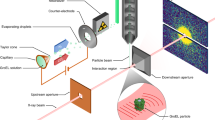Abstract
A SERIES of meridional and near-meridional reflections have been observed in X-ray diffraction patterns (ref. 1 and Fig. 1a) from the crab Plagusia leg muscle in the living, resting state, and have been attributed to troponin molecules which lie in pairs on thin filaments at 38-nm intervals. In the pattern (ref. 1 and Fig. 1b) obtained from the same muscle in rigor, the corresponding series of reflections was observed to have stronger intensities and higher order reflections. The reflections were interpreted as arising from both troponin and the cross-bridges. Electron micrograph2 showed that cross-bridges occurred in symmetrical pairs around the thin filaments with a repeating distance of 38 nm in which one or a few closely spaced pairs may be included. Recently, reflections indexed as orders of 76 nm in X-ray diffraction patterns from insect flight muscle in rigor3 and those from scallop striated muscle in rigor4 have also been interpreted in terms of the cross-bridges attached in pairs to thin filaments with a repeating distance of 38 nm. We report here a method that enables us to analyse diffractions generated by molecular arrangements of this type. These arrangements are described by a set of identical helices, and the systematic modulation of intensities, indexed as orders of 76 nm, is interpreted in terms of displacement between these helices.
This is a preview of subscription content, access via your institution
Access options
Subscribe to this journal
Receive 51 print issues and online access
$199.00 per year
only $3.90 per issue
Buy this article
- Purchase on Springer Link
- Instant access to full article PDF
Prices may be subject to local taxes which are calculated during checkout
Similar content being viewed by others
References
Maéda, Y., Matsubara, I. & Yagi, N. J. molec. Biol. (in the press).
Maéda, Y. thesis, Nagoya Univ. (1978).
Barrington-Leigh, J. et al. in Insect Flight Muscle (ed. Tregear, R. T.) 137–146 (North-Holland, Amsterdam, 1977).
Vibert, P. et al. Nature 273, 64–66 (1978).
Ohtsuki, I. J. Biochem., Tokyo 75, 753–765 (1974).
Ebashi, S. Nature 240, 217–218 (1972).
Franklin, R. E. & Klug, A. Acta crystallogr. 8, 777–780 (1955).
Cochran, W., Crick, F. H. C. & Vand, V. Acta crystallogr. 5, 581–586 (1952).
MacGillavry, C. H. & Bruins, E. M. Acta crystallogr. 1,156–158.
Offer, G. & Elliott, A. Nature 271, 325–329 (1978).
Miller, A. & Tregear, R. T. J. molec. Biol. 70, 85–104 (1972).
Reedy, M. K. J. molec. Biol. 31, 155–176 (1968).
Reedy, M. K. & Garett, W. E. in Insect Flight Muscle (ed. Tregear, R. T.) 115–136 (North-Holland, Amsterdam, 1977).
Author information
Authors and Affiliations
Rights and permissions
About this article
Cite this article
MAÉDA, Y. X-ray diffraction patterns from molecular arrangements with 38-nm periodicities around muscle thin filaments. Nature 277, 670–672 (1979). https://doi.org/10.1038/277670a0
Received:
Accepted:
Published:
Issue Date:
DOI: https://doi.org/10.1038/277670a0
This article is cited by
-
The arrangement of myosin heads in relaxed crab muscle
Nature (1983)
Comments
By submitting a comment you agree to abide by our Terms and Community Guidelines. If you find something abusive or that does not comply with our terms or guidelines please flag it as inappropriate.



